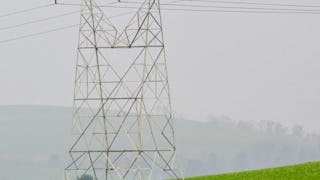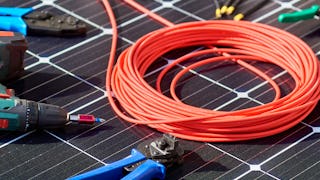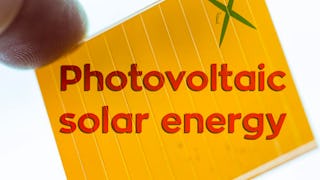This course gives you an introduction to the fundamentals of solar power as it applies to solar panel system installations. You will learn to compare solar energy to other energy resources and explain how solar panels, or photovoltaics (PV for short), convert sunlight to electricity. You will be able to identify the key components needed in a basic photovoltaic (solar panel) system, such as is found on a house or building, and explain the function of each component in the system. You will also learn how to calculate the electrical demand of a building, how to reduce the overall demand, and then how to design a solar panel system that can meet that annual demand at a given location. You will also compare the different types of pricing models that are being used and key regulatory considerations for grid tied systems (where a house or building is connected to the electrical grid and also generates electricity from solar panels). A capstone design project that entails both the simple audit of a building to determine demand, and a selection of components to design a solar panel system to meet that demand.


(2,583 reviews)
Recommended experience
What you'll learn
Calculate the energy usage at a location
Design a basic photovoltaic system to meet a specific energy need at a specific location
Describe financial models and trends in the photovoltaic energy field
Skills you'll gain
Details to know

Add to your LinkedIn profile
See how employees at top companies are mastering in-demand skills

There are 5 modules in this course
Welcome! This first module will give you an introduction to the various forms of energy available to us on the Earth and how solar power fits into the overall mix. It will also introduce you to the various parts that go into that solar panel system you see on a house or other building, both the obvious parts and the less obvious pieces. Lastly, you'll learn how to calculate the efficiency of a solar panel as it takes in light energy from the sun and converts it to electricity.
What's included
10 videos2 readings5 assignments
Before you design a PV system for a home or commercial building, you need to know how much energy is being used at that location. That energy need helps you determine the size requirements of a PV system to meet that energy need. You also need to know how much energy can be produced by a PV system, because it varies based on the amount of sunlight available. In this week's module you will learn how to differentiate and calculate power and energy for both energy consuming appliances and energy producing photovoltaics, and then apply those concepts and calculations to assessing energy needs and energy production potential at a site.
What's included
6 videos2 readings4 assignments
Photovoltaics is a growth industry. In this module you will be learning about the historical development of photovoltaics, the current trends, and some of the future forecasts of the market both globally and with a little bit of a closer look at the United States. Finally, you'll be learning about the segmentation of photovoltaics into different applications beyond just solar panels on a house or a solar farm.
What's included
4 videos2 readings4 assignments
The field of photovoltaics engages many people filling many different roles. In this module you will learn about the different stakeholders and job opportunities in PV. You'll also learn about some different certifications available to those already working in the photovoltaics industry and for those interested in joining the field. You'll also learn about the different financial models associated with PV systems that underpin the implementation of on-grid PV systems. When you finish this module I would recommend at least starting your work on the capstone project rather than waiting until the following week.
What's included
4 videos1 reading4 assignments
In the capstone project you will be applying some of key skills you have learned so far in this specialization. You will need to evaluate a site's location, calculate it's energy consumption and try to reduce it's load, and then design a solar array capable of meeting it's total energy load using data from commercial modules and using a simplified assumption about system efficiency as we have been doing in this course.
What's included
1 peer review
Instructor

Offered by
Explore more from Environmental Science and Sustainability
 Status: Free Trial
Status: Free TrialUniversity at Buffalo

The State University of New York
 Status: Free Trial
Status: Free TrialUniversity at Buffalo
 Status: Preview
Status: PreviewÉcole Polytechnique
Why people choose Coursera for their career




Learner reviews
2,583 reviews
- 5 stars
81.53%
- 4 stars
15.79%
- 3 stars
1.70%
- 2 stars
0.42%
- 1 star
0.54%
Showing 3 of 2583
Reviewed on Jul 10, 2020
the course content is very good for starting off from basics of solar photovoltaics. concepts are explained properly. assignment problem and quizzes were also very interesting. real recommendable.
Reviewed on Jun 22, 2021
This is a wonderful course where I studied a lot about solar energy and a lot more.As I have completed my course in my 1st year of Electrical Engineering I has got a clear picture of the subject.
Reviewed on Oct 5, 2019
This course is excellent! It includes all the important topics you need to know about solar energy and it is easy to understand. Definitely, it was a great decision to take it.

Open new doors with Coursera Plus
Unlimited access to 10,000+ world-class courses, hands-on projects, and job-ready certificate programs - all included in your subscription
Advance your career with an online degree
Earn a degree from world-class universities - 100% online
Join over 3,400 global companies that choose Coursera for Business
Upskill your employees to excel in the digital economy
Frequently asked questions
To access the course materials, assignments and to earn a Certificate, you will need to purchase the Certificate experience when you enroll in a course. You can try a Free Trial instead, or apply for Financial Aid. The course may offer 'Full Course, No Certificate' instead. This option lets you see all course materials, submit required assessments, and get a final grade. This also means that you will not be able to purchase a Certificate experience.
When you enroll in the course, you get access to all of the courses in the Specialization, and you earn a certificate when you complete the work. Your electronic Certificate will be added to your Accomplishments page - from there, you can print your Certificate or add it to your LinkedIn profile.
Yes. In select learning programs, you can apply for financial aid or a scholarship if you can’t afford the enrollment fee. If fin aid or scholarship is available for your learning program selection, you’ll find a link to apply on the description page.
More questions
Financial aid available,
¹ Some assignments in this course are AI-graded. For these assignments, your data will be used in accordance with Coursera's Privacy Notice.

